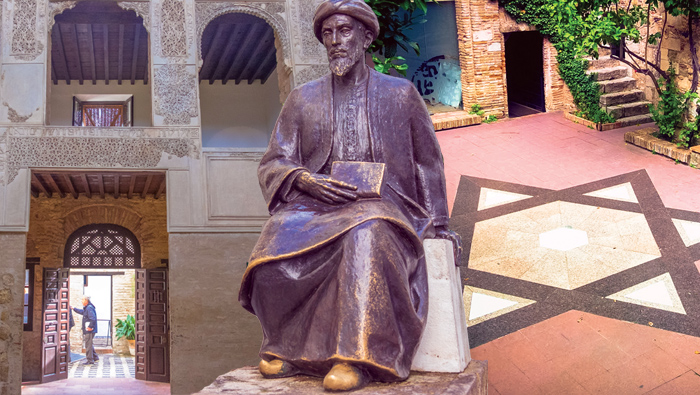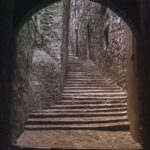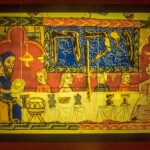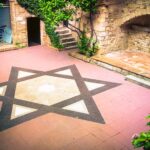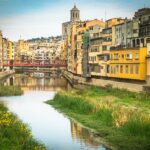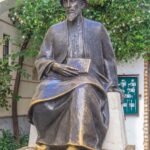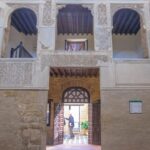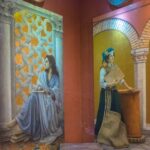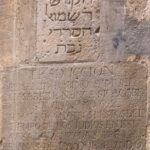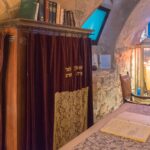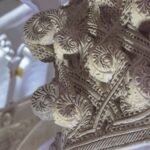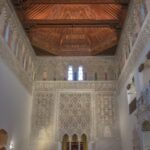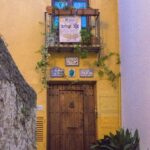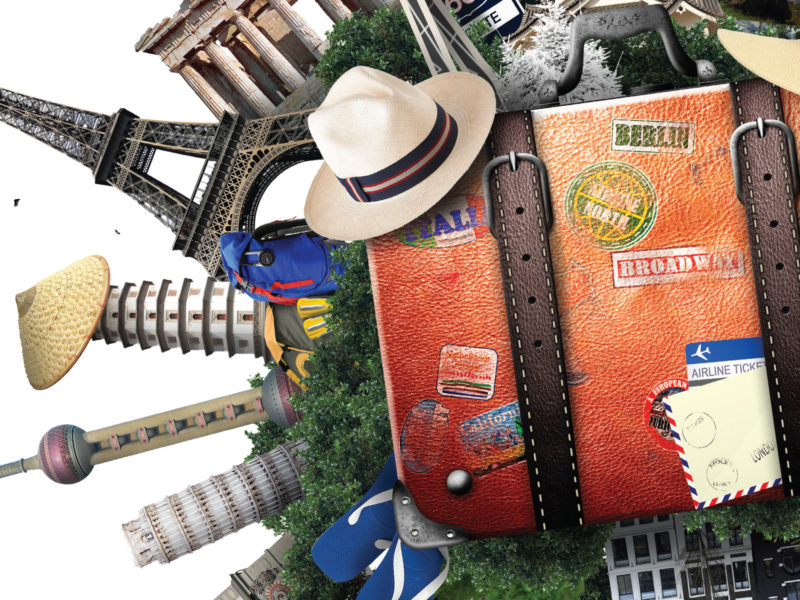Story and photos by Jay Chatzkel
Our recent travels in Spain became more meaningful – and a bit more of an adventure – when my wife, Barbara, and I included visits to Jewish heritage sites. Over the last 100 years, and especially since the 1970s, sites have been recovered and restored by private initiatives, as well as an official Spanish government remembrance program.
We had only a vague idea of what we would find when we began exploring Jewish heritage sites in Spain. For example, as Americans, the year 1492 marks Columbus’ “discovery” of the New World. In our travels, we learned there was another side of the coin to that date: the year that Jews were officially expelled from a newly united Spain.
Our trip – which included stops in Barcelona, Girona, Toledo, Madrid, Granada and Córdoba – was a chance to fill gaps in the story.
While we found most heritage sites in guidebooks and on the internet, we discovered others by asking a lot of questions – and with a certain amount of luck. There is truth to the statement that the harder you work, the more luck you have. Our pre-work and persistence paid off. Here are a couple of highlights.
GIRONA
A half-hour train ride north from Barcelona is the town of Girona, with a historic district considered to have the best preserved medieval town and Jewish Call in Spain. In the late 800s, Jewish families began living in Girona, where the Jewish population grew to about 1,000. Surprising to us, but not unique, was that the Jewish Call was next to the Girona Cathedral. This was how Catholic Church authorities kept an eye on the Jewish settlement. The Jewish community paid taxes to the Church in return for its protection and regulation.
From the 900s through the 1200s, Girona became a vital center for traditional Torah study and mystical kabbalistic studies, which gained it the name “the Mother City of Israel.” It was home to one of the most prominent rabbis of the era, Rabbi Moshe ben Nahman – better known as Nahmanides and also referred to as the acronym Ramban – as well as other leading scholars.
The pogrom of 1391 brought an end to Girona’s Jewish community, whose history was then forgotten for over 500 years. In the 1970s, a Catalonian poet bought some properties in the old town to remodel into a restaurant. While working on the old structures, he discovered the foundations of Nahmanides’ yeshiva. Shortly afterward, the new mayor of Girona, a historian, recognized the value of the Jewish contribution to the city and turned the ancient buildings into the Museum of Jewish History, which today also serves as a center of study.
We went to Girona to visit the museum, not knowing what else we would find. As we walked the old stone streets of the Call, we passed a Jewish center where a Yom Kippur service was in progress. As we started our tour of the museum, we heard a voice call out, “Are you Jewish?” We turned and saw a young bearded man in a beautiful tallit and yarmulke. He encouraged us to join the Yom Kippur service at the Jewish center. It was as if an angel had come out of sky to seek us out – so of course, we did.
In a scene that could have come out of a Marc Chagall painting, we followed the young man in the flowing tallit up the ancient, winding stone street to the Chabad of Girona Jewish center to the service. (The Rosh Hashanah service the previous week was the first of the New Year in Girona for 600 years…imagine that!)
The prayer books were mostly in Hebrew and Spanish, but because of the variety of visitors to Girona, there were also several in English, French and Russian. Our rabbi had also “recruited” a couple from Paris who were in Girona for the weekend. Other congregants included a retired dentist from Yuma, Arizona and his wife, who had visited Girona on a cruise and fallen in love with it before deciding to live there permanently.
During the service, we came to the Yizkor memorial prayer. Because the rabbi’s parents are still living, he had to leave until the prayer was completed. To my surprise, he asked me to lead the Yizkor service. I approached the ark, where the rabbi pulled my tallit over my head and walked away. I was honored but more than a little apprehensive, since I had never led a Yizkor service, let alone one in a foreign country. Using the Hebrew/English prayer book, I led our multinational group of congregants through the service, taking the Torah out of the ark and holding it in front of the congregation.
After the service, we returned to the Museum of Jewish History and finished our tour. We walked through the story of the Girona Jewish community over the centuries, the attacks of 1391, the Spanish Inquisition and, finally, the 1492 expulsion. The museum has an extensive collection of medieval Jewish artifacts, including massive tombstones, deeds, menorahs, stone blocks from doorways with channels carved out for mezuzot and articles from every area of Jewish life. The museum’s second floor has an outdoor plaza with a large Star of David and an arch with a menorah from an earlier site dedication.
Our new friends from Yuma took us on an “insider” walking tour of historic Girona, guiding us to a number of Jewish heritage sites that only someone who lives there would know, including a garden where the Kabbalah community leaders gathered and which is now memorialized with plaques bearing their names.
- Street of the Jewish Call.
- Museum of Jewish History – Medieval Sephardic family at their meal.
- Museum of Jewish History outdoor plaza.
- Name plate honroing cabalist in meeting place garden.
- Old city – river view.
CORDOBA
Córdoba has the only remaining medieval synagogue in southern Spain. It is the city where Maimonides lived and wrote his great works.
Although most evidence of the vibrant culture – which was rich in scholarship, poetry and philosophy – of the Jewish community is gone, with some imagination and a visit to the recently founded Casa de Sefarad museum, that history returns to life.
The ancient synagogue, built in 1315, is a lovely, well-preserved building, despite the passing of hundreds of years. In the 1400s, it was taken over for use as a hospital and then, interestingly, as a shoemakers’ guild. The walls filled with decorative script were covered over and left undisturbed, a testament to their good condition. When the ceiling of the building collapsed in the 1850s, the original Hebrew script covering it and its walls was revealed. The synagogue was restored reopened as a museum. Although much smaller, its design is similar to the Synagogue of El Tránsito in Toledo, Spain, since they were both built at approximately the same time.
Near the synagogue is Maimonides Square, with its bronze sculpture of Maimonides sitting with a book in his hands, possibly his Guide to the Perplexed. The front of his right shoe is well worn, prompted by the story that if you rubbed it with your hand, some of Maimonides wisdom would rub off on you. Everyone who visits the sculpture, myself included, makes sure to give it a try. Nearby is the Casa de Sefarad and the House of Memories, a center for learning the history and culture of medieval Jewish Córdoba. Casa de Sefarad also hosts a wide variety of performances in its cultural arts space and is home to a repository of books and materials on the medieval Jewish world. Casa de Sefarad was founded by a professor from Seville who saw that the rich heritage of Córdoba was in danger of being lost. He made it his mission to open the center in remembrance of the Jewish contribution to the world, which he accomplished with private funds and no government involvement.
The Casa de Sefarad – located in Córdoba’s Jewish Quarter, a UNESCO World Heritage Site – attracts a large number of tourists who are curious about this unique world. The Casa’s committed staff take visitors through its exhibits and hosts them at performances linked to Córdoba’s traditions. I toured the Casa in the afternoon and returned later in the evening for a flamenco performance in the courtyard, its floor inlayed with a mosaic Star of David.
Córdoba was a fitting end to this journey. The search for the Jewish heritage of Spain does not always mean finding synagogues, ancient tombstones and signs that mezuzot were once placed inside doorways. Jewish heritage resurrects the history and contributions of a people who once represented ten percent of the population on the peninsula but who now number less than one half of one percent of Spain’s population.
Córdoba has its rare synagogue but is also a place where a great philosophic, arts and religious heritage was cultivated – and represents the background that shaped much of who we are today. Discovering all of these elements of Jewish heritage is a journey of finding one’s own heritage and origins. It is also an exploration of the Sephardic tradition, one that is known only to a small extent by the majority of Jews who come from Central and Eastern European Ashkenazi traditions.
Finally, is it a journey that takes many paths. The Spanish and local governments are making efforts to create monuments of remembrance. Others believe that going the unfettered route of autonomous, private funding is the only real way to creating a living memory of the contribution Jewish heritage to the Spain of today. Most likely it will take both public and private efforts, by Jews and non-Jews, to bring the renaissance of Spain’s Jewish heritage to full bloom. This discovery was as heartening as it was unexpected.
The greatest achievements of the earlier Jewish communities of Spain were collaborative efforts that crossed cultures and religious groups. And we found similar, transforming efforts to break down boundaries happening today.
- aimonides Statue in Maimonides Square.
- Inside the Ancient Synagogue, built in 1315.
- Casa de Seferad paintngs.
(The following cities were not included in March 2017 print story)
BARCELONA
We started in Barcelona with a visit to the city’s Ancient Synagogue, which dates back to the 6th century and is the oldest synagogue in Spain. Located in what was the Jewish Call, a term that describes the warren of narrow passages in the Jewish quarter, the streets and buildings appear much the same as they did 800 years ago.
After years of researching the area, in 1996 a historian finally located the site of the Synagogue Mayor the basement of a 17th-century building. The synagogue was restored and reopened in 2002 by the private non-profit Associacio Call de Barcelona. It has two rooms, with its height limited by royal decree in 1267 to be no higher than the smallest church in the city.
The building is a combination of different eras. The first room has a Roman wall at its base, with a stone inscribed “XIIX” from the second century, as well as a medieval well from when the space was used for dying cloth. The second room that became the worship space was added in the 13th century. It has niches in two walls that face east to Jerusalem for placing Torahs. The worship room is home to a donated 500-year-old Torah along with different collections of artifacts from medieval times.
When you visit, you feel transported back into an earlier time. Realizing that you are sitting in the exact place where worship services took place into the 1300s, is a haunting experience.
The synagogue now serves as a museum and cultural center. A steady stream of visitors stoop as they walk down the six steps to the synagogue floor, as the street level then was six feet lower than it is now. While it has not been decommissioned, the worship room is available for services, Kaddish, weddings and bar and bat mitzvahs. Photos on the walls of a Rosh Hashanah service give a glimpse of the link between the present and the past in a way that stirs the imagination.
The Barcelona Jewish community existed from at least the sixth century and continued for 700 years, growing in numbers to a population of 4,000 in the 1300s. The Barcelona Call also became a refuge during troublesome times. Some refugees were French Jews who fled France after their expulsion there, building their own their own French synagogue around the corner from the Synagogue Mayor.
The community flourished, albeit unevenly, over the centuries until the 1300’s when pressures intensified on Jews to convert to Christianity. It is said that of the approximately 300,000 Jews living in Christian held Spain in the 1200’s; only 100,000 continued to practice Judaism by the time of the 1492 Expulsion. For Barcelona, the critical event leading to the demise of the Jewish community came earlier, during the summer of 1391, when a wave of assaults swept Jewish quarters across Spain. The pogroms reached it on August 5, 1391, and resulted in a massacre of 300 Jews. Jews had two choices: convert or flee. The synagogue was expropriated shortly afterward by the king. Within months the Jewish presence in Barcelona ended, not to return for over 500 years.
Barcelona currently has the largest Jewish population in Spain with three synagogues: progressive, a joint congregation of orthodox Sephardic and Ashkenazi, and the Chabad community. The Phoenix Chabad congregation’s rabbi generously arranged an invitation for us to be guests at Chabad’s Barcelona congregation Kol Nidre service. We found that, while there were differences in melodies and some practices, we could follow quite well even though prayer book was in Hebrew and Spanish.
- Commemorative plaque honoring a rabbi at the synagogue.
- Worship space inside the synagogue.
TOLEDO
If you only were able to visit one Jewish heritage site in Spain, Toledo and its two surviving synagogue structures could well be it. Toledo is a one-hour train ride south from Madrid. It was a major Jewish population center during 400 years of Islamic rule and then flourished even more after the Christian king conquered it in 1085. When a more fundamentalist, fanatical sect of Berber tribesman crossed into to the Islamic kingdoms from North Africa and vanquished the more tolerant rulers in 1135, the Jewish population fled the Islamic states for sanctuary in the Christian north. Toledo soon became a destination, attracting poets, philosophers, doctors, scientists and scholars, reaching new heights as a vibrant center for Jewish culture.
“Magnificent” is a one-word description for the El Transito Synagogue, which now operates as the Sephardic Museum. The El Transito synagogue, built about 1356, was the private family synagogue of Samuel ha-Levi Abulafi, Treasurer to Pedro of Castile (also known as Pedro the Cruel). The king gave ha-Levi his assent for the exception from the laws that a synagogue must be smaller, lower and plainer than any church in the realm. While the synagogue is not remarkable in its exterior, its interior is an architectural triumph, integrating tile floors with walls covered by polychrome Hebrew quotations from the Psalms, praises for ha-Levi’s patron, King Pedro, and not inconspicuously, for ha-Levi, himself. These monumental inscribed friezes are considered the best examples of their type in the world and works of art on their own. Its arched windows let in light and are topped by a massive, decorated paneled ceiling. Everything about the building reveals a time of an easier co-existence of the three cultures of Judaism, Christianity and Islam. El Transito was built by a wealthy, highly positioned Jew in the Christian court, sanctioned by the Christian king, and crafted by Muslim architects and skilled workmen.
The structure’s grand design inspired me to think about the quality of life that existed there almost 700 years ago. We are very proud of our 21st-century accomplishments, seeing ourselves as highly advanced over people who lived centuries before us. However, touring the El Transito Synagogue was a humbling experience, bringing me to consider that perhaps we are not as exceptional as we think we are.
Today’s official name of the building is the El Transito Synagogue and Sephardic Museum and is operated as a museum by the Spanish government. The former King of Spain, Juan Carlos I, took it upon himself to lead what he sees as the “righting of historic wrongs” and takes to heart reconciling with its Jewish population and the past, remembering the contributions of its Jewish population before the Expulsion of 1492. The restoration of the Synagogue and its related museum grow out of that effort.
The history of the Synagogue reflects the history of the Jewish people in Spain, both the high and low points. The high points mirror the glory of the Golden Age, and the low points that followed are the pogroms and the eradication of anything Jewish. The circle has finally been closed, as seen in the renovation and restoration the Synagogue, the remembrance of the Jewish contributions to Spanish life, and the recognition of today’s Jewish community.
Toledo’s other existing former synagogue is within sight of El Transito. Built in 1180, it is believed that it was originally called the Ibn Shushan Synagogue or the “Congregational Synagogue of Toledo.” It is one of the oldest synagogues still standing. After 1411, it was taken over and later renamed the Santa Maria la Blanca Church, which translates as Saint Mary the White, which was part of an effort to “cleanse the building of what was considered its ‘dark’ Jewish past.”
Through the ironies of history, the building is currently owned by the Catholic Church which operates the synagogue as a museum. However, a request has been formally made by the Spanish Jewish organizations to the Church to return it to the Jewish community.
Like the El Transito, the Ibn Shusan Synagogue had a royal backing and a sponsor who, as the son of the finance minister to King Alfonso of Castile, had a strong connection to the king’s court. Being 200 years earlier than its neighboring El Transito, it has a quite different design. Despite the difference in eras, it was also constructed in a Christian kingdom by Islamic architects and workers for the purpose of being used as a Jewish place of worship. When we consider the chances for that extent of collaboration taking place in today’s divisive world, we can begin to get an idea how much more open to each other the three different cultures were then we manage to do in today’s world. All too often these periods of harmony were followed by times of hostility, civil wars and a zealous, fundamentalist, repressive regimes. The Jewish communities were a key to the Golden Ages when a wise ruler governed, but dangerously vulnerable when a new, hostile king came to power.
The Santa Maria la Blanca building also has strong elements of Moorish design but is far simpler than the Synagogue of El Transito. The interior is one floor with five rows of arched columns. Its walls are plain, although some of the original decorative tiles on the floor can still be seen, giving a glimpse of a more grand design. One observation is that the building has more in common with a mosque than a synagogue, and that is probably true.
- El Transito Synagogue upper wall and ceiling.
- Fragment of wall inscription.
- Ibn Shusan Synagogue column and arches.
- Ibn Shushan Synagogue interior.
- Interior of El Transito Synagogue, built in 1358.
GRANADA
Granada draws visitors world-wide to its incomparable Alhambra Palace, considered the highest expression of Islamic culture and art in Spain. Granada was the last Moorish stronghold in Spain to fall, surrendering to King Ferdinand and Queen Isabella of Spain in 1492, who shortly afterward issued the Edict of Expulsion, closing out the Jewish presence in Spain until the 20th century.
Less appreciated is that Granada was a great Jewish learning center, reaching the high point of its Golden Age in the 11th century. A refugee from Cordoba, Samuel Ha’Nagid, arrived and became a scribe in the Caliph’s court. His exceptional abilities were recognized by the Caliph, and he rose who over time to be the Caliph’s vizier, or prime minister. He not only led the government as chief minister but also led the Caliph’s army into war, writing poetry on the eve of battles.
Beyond his governance roles, Ha’Nagid was equally devoted to making Granada an important center of Jewish learning. Upon his death, Ha’Nagid’s son, Joseph, took over his position. Unfortunately, Joseph was a divisive figure, and his arrogance provoked rage among the peoples of Granada who felt displaced by him. In 1066, they revolted, killed Joseph, put the Jewish community under siege, and massacred, according to accounts, 4,000 Jews. The remaining Jewish population fled, although some returned living between periods of quiet and then repression for the next two hundred years. The 1492 expulsion extinguished any remaining Jewish presence.
While the Jewish community had a long history in Granada, there are sadly few physical remembrances of the Jewish experience remaining in there. A Sephardic couple, Gabriel Perez and Beatriz Cavalier, took it upon themselves to resurrect the Jewish presence by establishing The Center for Sephardic Judaism there in 2013. Their goal for the Center is to be a space that keeps the memory and practices of the Jewish experience in Granada alive in our generation.
Beatriz Cavalier was very clear that their Center is independent and autonomous, getting no support from the Spanish government. She feels that way can tell its story without any bias or obligation.
As I looked down the entranceway, I saw a room arrayed with the symbols of Sukkot, ready for the holiday service and meal. Exhibit rooms are filled with the kinds of objects that would have been found in a typical house in the Jewish quarter as well as documents that show the history of the Jewish community. There is also a library and a small space for cultural performances that you would not find elsewhere in Granada.
The Center’s self-directed and privately supported effort is the spark that keeps allows Granada’s distinctive Jewish history and culture to remain alive.
- Center for Sephadic Judaism – Sukkot table.
- Center for Sephardic Judaism front entrance.
MADRID
Since Madrid has no remaining Jewish Heritage sites, we did not anticipate to find much Jewish history while we were there. Madrid’s smaller Jewish medieval population fell victim to the murderous massacres of 1391. It took 600 years before Jews next returned to Madrid seeking refuge from World War I conflicts in other parts of Europe. These refugees were later joined by Sephardic Jews from Morocco and by Ashkenazim during the military rule in Argentina. There are now roughly 10,000 Jews in Madrid, as well as several synagogues and an array of other Jewish institutions. And yes, it is possible to get a kosher meal there.
Our unexpected discovery in Madrid came as we toured the streets of its historic city center. By pure chance, we spotted a sign for the “Centro Sefarad Israel” and went in to find out what is was about. The Centro was not listed in our guidebooks or referenced by Jewish tour groups. We were fortunate to meet Fernando Vera de Ray, the Centro’s Director of Communications and Institutional Relations, who shared with us the role the Centro has in today’s Spain and gave us a personal tour.
The Centro was founded in 2006 as a joint effort of the Spanish Government’s Ministry of Foreign Affairs, the regional Madrid governing body and the Madrid City Council. Its mission is to “deepen the study of the legacy of Sephardic culture as a living part of Spanish culture, as well as foster greater knowledge of Jewish culture within Spanish society.” Additionally, it has the goal to promote friendship ties between Spanish society and Israeli society. It has taken on the role of being an open meeting space for communities and Jewish organizations in Spain and worldwide. The Centro is part of the Spanish government’s efforts to reexamine its past, valuing the rich Jewish legacy to its culture, as well as the special relationship between Israel and Spain.
A testimony to the importance of the Centro to the Spanish government is that the then King Juan Carlos and Queen Sofia, along with the Shimon Perez, President of Israel at the time, participated together in the inauguration of the new headquarters of the Centro in 2011.
During our visit, the Centro was holding a multi-room exhibition of the works of Israeli artist Daniel Shinasi. Upcoming events show the range of the Centro’s interests including a Hanukah celebration on the streets outside the Center, Sephardic music concerts, exhibits and conferences on the contributions of Jewish learning and culture in Spain and other countries. Also, the Centro holds seminars on the tough issues such as anti-Semitism in Spain and special nature of Spanish-Israeli relationships.
The Centro has the challenge to make itself relevant and influential across the whole of Spain, while at the same time serving as an ambassador to Israel and other countries across the world. We felt this was a significant and sincere level of effort and wished that, whatever its limitations, something of a similar nature would take place here in the United States, as well as other countries.
If you are thinking of visiting Spain, consider taking time to learn about its rich Jewish heritage. The Jews of early Spain saw it as a place of promise and, to the degree they could, they fulfilled that promise. Take the time to visit historic sites across Spain and experience this unique heritage – your heritage.
Use the links below to help you develop your itinerary, or contact one of the tour companies that conduct Jewish heritage site and culture tours.
Some suggested links:
http://www.jewishvirtuallibrary.org/
http://worldjewishheritage.com/spains-top-10-must-see-jewish-quarters-2/ http://www.totallyspaintravel.com/2015/10/30/jewish-heritage-sights-in-spain/
http://www.elitetraveler.com/wp-content/uploads/2013/06/SpainJewishHeritageGuide_new.pdf
http://www.naomiragen.com/travel/a-spanish-jewish-itinerary/
http://www.jewish-heritage-europe.eu/spain/heritage-heritage-sites
Feel free to contact Jay Chatzkel at [email protected].


